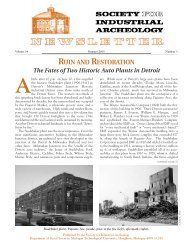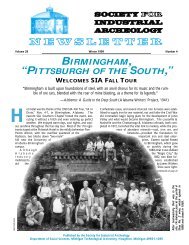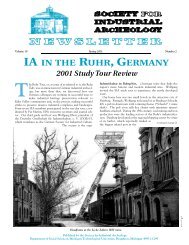Occasional Electronic Publication No. 1 - Society for Industrial ...
Occasional Electronic Publication No. 1 - Society for Industrial ...
Occasional Electronic Publication No. 1 - Society for Industrial ...
You also want an ePaper? Increase the reach of your titles
YUMPU automatically turns print PDFs into web optimized ePapers that Google loves.
Howe Configurations<br />
A Howe truss is characterized by rectangular panels with tension verticals and compression diagonals.<br />
The most commonly built variations of the Howe truss used timber <strong>for</strong> their upper chords and crossed<br />
diagonals, and wrought-iron <strong>for</strong> their lower chords and verticals. Although technically a “combination”<br />
truss due to the use of two materials, truss literature often refers to these examples as timber trusses, no<br />
doubt due to the earlier all-timber examples.<br />
PATENT CHRONOLOGY<br />
Howe truss - compression diagonals & tension verticals.<br />
Howe truss with counters<br />
Long, G. 1830: Timber. Polygonal top chord. Single compression diagonal in each panel.<br />
Long, S. 1830, 1836, 1839: All of Steven Long's patented trusses have timber chords and web members. Due<br />
to the joinery system they have tension verticals and compression diagonals. They have no iron members.<br />
Howe 1840, July: Timber. Pattern of V-shaped bracing in each panel. Full-span arch.<br />
Howe 1840, Aug.: Crossed, double-intersecting, compression diagonals. All-timber except <strong>for</strong> vertical rods.<br />
Osborn 1845: First all-metal Howe truss configuration. <strong>No</strong>t patented.<br />
Hassard 1846: Timber. Multi-panel struts at ends.<br />
Harbach 1846: Iron pipe used <strong>for</strong> all members except <strong>for</strong> vertical rods.<br />
Childs 1846: Timber except <strong>for</strong> counter rods.<br />
Fink 1857: Timber. All panels have crossed diagonals plus ties from diagonal intersections to lower chord.<br />
Briggs 1858: Timber chords. Rubber pad “springs” in compression joints.<br />
Ham 1859: Curved, iron, top chord, with three additional full-span arches.<br />
Jones 1860: Diagonals are pipes. Verticals are rods. Sloped end posts.<br />
Heath 1862: Forked diagonals. Screw sockets used <strong>for</strong> lower-chord connections.<br />
Jones 1863: Iron. Similar to the 1860 patent. Diagonals are stiffened.<br />
86






